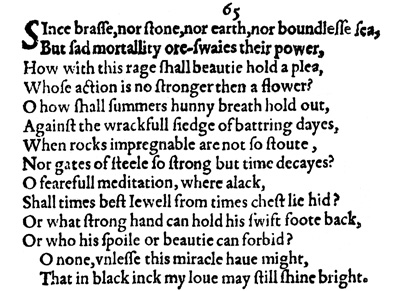In search of Fortune that favors everyone!!!!!Come, Explore & Share Roopa's Theistic Serendipity!
Wednesday, December 28, 2011
Shakespeare’s vision of life from Sonnets
Anaikatti -- an escapade of unexplored whereabouts
Monday, December 19, 2011
Sonnet 65- A detailed Analysis
- “Brass”,” Stone “, “boundless sea” – visual imagery ( can be observed)
- “Sad Mortality”, “wreckful siege of battering days”, “Time decays” – Conceptual imagery ( can hardly be visualized)
- “summer's honey breath”—conceptual and can pertain to touch which means one can feel the warm air of Summer
- “Rocks impregnable”, “gates of steel so strong”—literal imagery (which explains a fact)
- “Time's best jewel”, “Time's chest” –metaphorical usage which represents two different meanings.
Sunday, December 11, 2011
Sonnet 65 – An Introduction
William Shakespeare, the poet who brought definitive merging of Conceptual meaning &diction with a number of 154 sonnets that were authored in two distinct flavors. The essence that the sonnets primarily evince is brilliant with a tinge of logic around.
To comprehend what the sonnets elucidate, the reader needs to understand the personal life of Shakespeare interconnected to two others, namely, the Earl of Southampton & the Dark Lady. Predominantly, the sonnets revolve around these characters. The Earl of Southampton, a man of kindness, is said to be Shakespeare’s best friend and according to Shakespeare what a paradigm of exceptional charm is. The Dark Lady, her maiden name being Mary Fitton, is coy, flirtatious and her Love towards men termed inconsistent. She was Shakespeare’s mistress even before getting sensually attracted to the Earl of Southampton.
The division of the flavor that the sonnets reflect takes a perfect shape when Shakespeare gets dumped by his mistress. The first definite set talks about the matchless inspiration of Shakespeare, the Earl of Southampton and the second set about the humiliation from unattainable love.
In sonnet 65, the conceptual tug of war between time and love is excellently portrayed, bringing decisive content to limelight & getting off the ladder of Elizabethan Exuberance. This is what almost each critic of the century said. The uses of imagery in sonnets are wide, vivid, yet logical, hence divided as abstract and concrete. The abstract imagery is the relationship that runs amongst Shakespeare, Earl and the Dark Lady. Concrete Imagery is the usual representation of nature and entities that form the atmosphere of the verse.
Shakespeare also made clear that the idea of imagery is never confined within the limits of simply witnessing. Feelings, idea, movement also fall under imagery that one can actually feel. Theoretically those are the senses like Tactile, audio, visual, kinesthetic. However, Factuality & conceptuality chiefly account to the formation of imagery.
With a mix of broad use of imagery, cutting the use of mythological figures and tending to a Conceptual domination, Sonnet 65 ultimately pictures Subtle truth.






